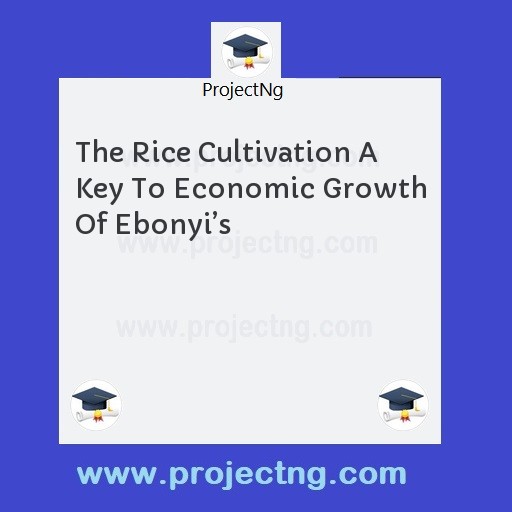The Rice Cultivation A Key To Economic Growth Of Ebonyi’s
Cooperative Economics Project Topics
Get the Complete Project Materials Now! »
THE RICE CULTIVATION A KEY TO ECONOMIC GROWTH OF EBONYI’S
ABSTRACT
This study investigate the technical and scale efficiencies in rice cultivation by rice farmers in Ebonyi State Nigeria using the data envelopment analysis (DEA). Data was collected form a sample of 180 farmers using multi-stage sampling technique. Data were analyzed using descriptive statistics and Data Envelopment Analysis (DAE) approach. The result showed that majority of the rice farmers here operating with increasing returns to scale 77.2%, 18.99% decreasing to scale and only 3.9% with constant returns to scale. Result of the analysis also showed that Education level farmers experience and extension agents. Visit significantly influenced the efficiency level of the rice farmers. Farm size was however negative correlated and had no significant effect on resource use efficiency of the rice farmers. The variable having significant influences on technical and scale efficiencies of the farmers such as education and extension agents visit should be improved upon to enhance the farmer efficiency level and reduce resources wastage and increased cost of production.
CHAPTER ONE
1.0 INTRODUCTION
1.1 BACKGROUND OF THE STUDY
It is pertinent at this juncture to define rice. First attested in English in the middle of the 13th century, the word “Rice” derive from old French “ris” which comes from Italian Riso, in turn from latin Oriza, which derive from the Greek (Oruza). The greed word is the source of all European words (of, Welsh rice, Ger, rcis, Lict, ryzai, Serbo, cr, riza, pol.ryz, Dutch. Rijst, Romania Ores). The origin of the Greek word is unclear. It has sometime held to be from the tamil word (Arisi) or rather old Tail Arich.
Rice can be defines as the seed of the mocot plant Oryza sativa (Asian rice) or Oryza glaberrima (African rice). As a creal gain, it is the most widely consumed staple food for a large part of the world’s human population, especially in Asia and the west Indies. It is the grain with the second highest world wild production after maize.
Rice is the most important grain with regard to human nutrition and caloric intake providing more than one fifth of the calories consumed world wild by the human species. There are many varieties of rice and culinary preference tends to vary regionally. In the Far East there is a preference for softer and stickier varieties because of its importance as a stapple food, rice has considerable cultural importance. Rice is often directly associated with prosperity and fertility therefore; there is the customer of throwing rice at weddings.
Rice is normally grown as an annual plant, although in tropic areas it can survive as a perennial and can produce a ration crop for up to 30 years. Rice plant can grow to 1 – 1.8m (3.3 -5.9ft) tall, occasionally more dispensing on the variety and soil fertility, it has long, slender leaves 50 – 100cm (20 – 39) long and 2 – 2.5cm (0.79 – 0.98) broad.
The small wind pollinated flowers are produced in a branched arching to pendulous inflorescence 30 – 50cm (12 – 50) long. The edible seed is a grain (caryopsis) 5 – 12mm (0.20 – 0.47 in) long and 2 – 3mm (0.79 -0.12 in) thick.
Rice cultivation is a well suited to countries and regions with low labour cost and high rainfall and labour intensive to cultivate and requires ample water. Rice can be grown practically anywhere, even on a steep hill or mountain. Although its parent species are native to Asia and certain parts of Africa, centuries of trade and exportation have made it common place in many culture world wide. The traditional method for cultivating rice is flooding the fields while or after setting the young seedlings. The simple method requires sound planning and servicing of the water doming and channeling, but reduces the growth of less robust weed and pest plants that have no submerged growth state and defers ermin. While flooding is not mandatory for the cultivation of rice, all other methods of irrigation require higher effort in weed and pest control during growth period and a different approach for fertilizing the soil. The name wild rice is usually used for species of the grass genue zizania both wild and domesticated although the term may also be used for primitive or uncultivated varieties of oryza.
1.2 STATEMENT OF THE PROBLEM
The rice cultivation in world wild has viewed as an important tools for the economic growth of the nation. The problem centered on.
The little knowledge on rice cultivation or no familiarity wit the organism. Most people find it difficult to grow and are disconnected from the large, national community of rice but today a new generation of rice cultivation has develop a feeding for the organism a connection to the national community.
Another stinking factor is the general law income of most people in the rural areas of Nigeria.
More so, it is the global vision of science and value of innovation, in Outreach, Education and also the introduce of New modern machineries, people can now be able to carry out the cultivation and harvesting of rice without much stress and also have quality education on how to apply the use of new modern machineries with these they can be able o raise enough capital. It is therefore on the foregoing promise that this research work becomes necessary in the first instance.
Be the First to Share On Social















